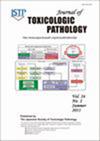食蟹猴自发性自身免疫性皮肤病1例
IF 0.9
4区 医学
Q4 PATHOLOGY
引用次数: 0
摘要
天疱疮是一种以皮肤和粘膜病变为特征的自身免疫性起泡疾病。迄今为止,在食蟹猴中没有自发性病例的报告。本报告描述了食蟹猴自发性天疱疮的组织病理学特征。宏观上,观察到全身皮肤发红、结垢并伴有瘙痒。组织病理学表现为表皮细胞间水肿,嗜酸性粒细胞和单核细胞浸润表皮。表皮未见明显棘松现象。血管周围水肿,嗜酸性粒细胞和单核细胞浸润真皮层血管。免疫组化结果显示,表皮细胞间区免疫球蛋白G和补体成分3阳性。血清学结果显示,血清抗粘粒蛋白1和抗粘粒蛋白3抗体均为阴性。根据这些发现,本病例被诊断为一种自身免疫性皮肤病,怀疑为天疱疮,并得出结论,病变与人类“疱疹样天疱疮”相似。本文章由计算机程序翻译,如有差异,请以英文原文为准。
A case of spontaneous autoimmune skin disease in a cynomolgus monkey (Macaca fascicularis)
Pemphigus is an autoimmune blistering disease characterized by lesions on the skin and mucous membranes. To date, no spontaneous cases of this disease have been reported in cynomolgus monkeys. This report describes the histopathological characteristics of spontaneous pemphigus in a cynomolgus monkey. Macroscopically, redness and scaling with pruritus were observed on the skin of the entire body. Histopathologically, the epidermis showed intercellular edema, and eosinophils and mononuclear cells infiltrated the epidermis. There was no obvious acantholysis in the epidermis. The perivascular area showed edema, and eosinophils and mononuclear cells infiltrated the vessels in the dermis. Immunohistochemically, the intercellular area in the epidermis was positive for Immunoglobulin G and Complement component 3. Serologically, anti-desmoglein 1 and desmoglein 3 antibodies in the serum were negative. From these findings, this case was diagnosed as an autoimmune skin disease, suspected to be pemphigus, and concluded as lesions being similar to those in human “pemphigus herpetiformis”.
求助全文
通过发布文献求助,成功后即可免费获取论文全文。
去求助
来源期刊

Journal of Toxicologic Pathology
PATHOLOGY-TOXICOLOGY
CiteScore
2.10
自引率
16.70%
发文量
22
审稿时长
>12 weeks
期刊介绍:
JTP is a scientific journal that publishes original studies in the field of toxicological pathology and in a wide variety of other related fields. The main scope of the journal is listed below.
Administrative Opinions of Policymakers and Regulatory Agencies
Adverse Events
Carcinogenesis
Data of A Predominantly Negative Nature
Drug-Induced Hematologic Toxicity
Embryological Pathology
High Throughput Pathology
Historical Data of Experimental Animals
Immunohistochemical Analysis
Molecular Pathology
Nomenclature of Lesions
Non-mammal Toxicity Study
Result or Lesion Induced by Chemicals of Which Names Hidden on Account of the Authors
Technology and Methodology Related to Toxicological Pathology
Tumor Pathology; Neoplasia and Hyperplasia
Ultrastructural Analysis
Use of Animal Models.
 求助内容:
求助内容: 应助结果提醒方式:
应助结果提醒方式:


